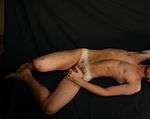Glamour photography

Glamour photography is a genre of photography in which the subjects are portrayed in erotic poses ranging from fully clothed to nude. The term may be a euphemism for erotic photography.[1] For glamour models, right body shape and size is directly related to success.[2] This is particularly true of the female breast, where having their size and shape altered by breast implants is considered crucial for success in the glamour industry.[2]
This type of photography is colloquially known as "cheesecake" for women and "beefcake" for men.[3][4]
Glamour photography is generally a composed image of a subject in a still position. The subjects of "glamour" photography for professional use are often professional models, and the photographs are normally intended for commercial use, including mass-produced calendars, pinups and men's magazines such as Maxim; but amateur subjects are also sometimes used, and sometimes the photographs are intended for private and personal use only. Photographers use a combination of cosmetics, lighting and airbrushing techniques to produce an appealing image of the subject.[5][6]
Early history
Until the later half of the 20th century glamour photography was usually referred to as erotic photography. Early erotic photography was often associated with "French postcards", small postcard sized images, that were sold by street vendors in France. In the early 1900s the pinup became popular and depicted scantily dressed women, often in a playful pose, seemingly surprised or startled by the viewer. The subject would usually have an expression of delight which seemed to invite the viewer to come and play. During World War II pin-up pictures of scantily clad movie stars were extremely popular among American servicemen. Betty Grable was one of the most famous pinup models of all time; her pinup in a bathing suit was extremely popular with World War II soldiers.
In December 1953, Marilyn Monroe was featured in the first issue of Playboy magazine. Bettie Page was the Playboy Playmate of the Month in January 1955. Playboy was the first magazine featuring nude erotic photography targeted at the mainstream consumer.
The British Queen of Curves in the 1950s and early sixties was Pamela Green. Harrison Marks, on the encouragement of Green, took up glamour photography and together in 1957 they published the pinup magazine Kamera. Currently in England the earliest use of the word "glamour" as a euphemism for nude modeling or photography is attributed to Marks' publicity material in 1950s.
Glamour models popular in the early 1990s included Hope Talmons and Dita Von Teese and the modern era is represented in the U.S. by models like Heidi Van Horne and Bernie Dexter, while the UK's leading representative of the genre is Katie Price and Lucy Pinder.
Magazines and movie stars
 |
|
| Problems playing this file? See media help. | |
Standards and styles of glamour photography change over time, reflecting for example changes in social acceptance and taste. In the early 1920s, United States photographers like Ruth Harriet Louise and George Hurrell photographed celebrities to glamorize their stature by utilizing lighting techniques to develop dramatic effects.[7][8]
Until the 1950s, glamour photography in advertising and in men's magazines was highly controversial or even illegal. In some countries, if not illegal, such magazines could not be on public display, and some had to be displayed in a plastic cover. Magazines featuring glamour photography were sometimes marketed as "art magazines" or "health magazines".
Popular portraiture
Since the 1990s glamour photography has increased in popularity among the public. Glamour portrait studios opened, offering professional hair and makeup artists and professional retouching to allow the general public to have the "model" experience. These sometimes include "boudoir" portraits but are more commonly used by professionals and high school seniors who want to look "their best" for their portraits.
Gallery
-

Isabel Sarli, circa 1973
-

Nude male model
-

Male model, 2009
-

Glamour portrait, 2011
-

Semi-nude male model, 2010
-

Semi-nude glamour model, using the handbra technique, 2007
-

Alyssa Nicole Pallett posing in a glamour photo, 2009
-
.jpg)
Nude glamour model, 2012
See also
Further reading
- Simpson, Mark (23 March 2015). "How men became the new glamour models". The Daily Telegraph. London.
References
- ↑ "glamour". Oxford English Dictionary. Oxford, UK: Oxford University Press. 2007. Retrieved 4 April 2014.(subscription required)
- 1 2 Coy, Maddy; Garner, Maria (November 2010). "Glamour modelling and the marketing of self-sexualization: critical reflections". International Journal of Cultural Studies. Sage. 13 (6): 657–675. doi:10.1177/1367877910376576.
- ↑ "Cheesecake" @ dictionary.com.
- ↑ Rosenberg, David (12 April 2015). "The Secret History of Hunky Male Beefcakes", Slate.
- ↑ Thomas, Mike (May 12, 1994). "Glamour Shots Take Writer from Bland to Bond". Toronto Star. Orlando Sentinel. Section B, p. J.3.
- ↑ Peterson, Maggie Wolff (September 1994). "The Glamour Side of Photography". North Valley Business Journal. 5 (11). Section 1, p. 1. (As cited by ProQuest (subscription required).) Publisher's website.
- ↑ LaSalle, Mick (January 16, 1995). "Lights Up on Hollywood's Hurrell / Special focuses on the inventor of the glamour-shot style". San Francisco Chronicle.(subscription required)
- ↑ "Legends in Light: The Hollywood Photography of George Hurrell". Hurrell Estate Collection. Retrieved January 16, 2015.
